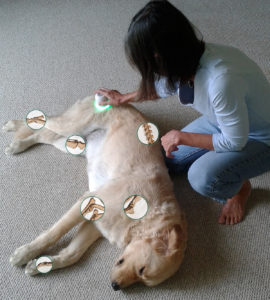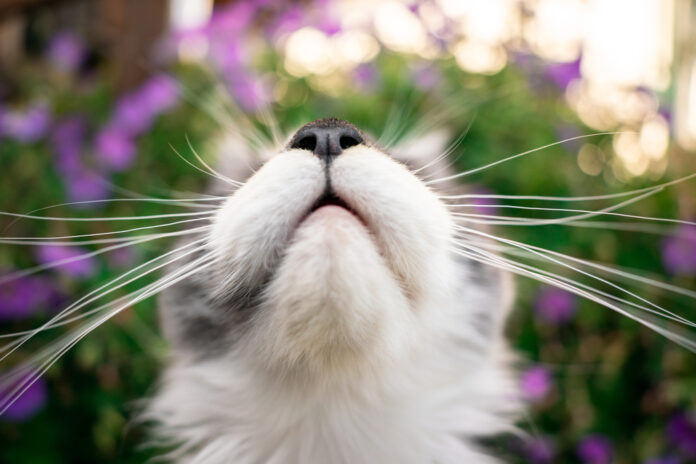Light therapy for dogs and cats

Light therapy is becoming a popular alternative for many pet ailments, from arthritis to muscle injury to wound healing. Here’s how it works and why it’s worth considering.
Like us, cats and dogs suffer from conditions such as inflammation, infections and arthritis. And no matter how closely we watch them, they’ll scrape their legs, cut their pads, jar their shoulders and sprain their ankles. A healing modality called low level light therapy (LLLT), otherwise known as photobiomodulation (PBMT), can help with all the above problems, and more.

What it is
Light therapy has been used as an alternative treatment in human medicine for over two decades. More recently, it has made its way into the veterinary world, where it’s quickly gaining a reputation as a safe, gentle and effective method of healing. “Light therapy is really a way to help the body heal itself,” says Christina Reguli, Owner of Canine Light Therapy. “When cells are damaged, they have to make the energy needed to repair themselves, but they are not efficient at doing that because of the damage.” That’s where light therapy comes in. Light therapy equips the cells with the ability to heal more quickly.
How it works
Using LEDs or LASER diodes, LLLT penetrates your animal’s skin, blood, muscle and bone using specific wavelengths of photons. Photoreceptors in your animal’s cells absorb this light energy, which enhances the healing process by giving the cells a boost of energy. Various wavelengths reach different layers of tissue. Red light, for example, is more efficiently absorbed by tissue rich in hemoglobin, and is beneficial for healing surface wounds and stimulating acupressure points. Near-infrared light is able to pass through to deeper tissues such as tendons, ligaments, bones, joints and muscle. Ideally, a combination of both red and near-infrared light is used in a light therapy session.
Photoreceptors in your animal’s cells absorb this light energy, which enhances the healing process by giving the cells a boost of energy.

The benefits of light therapy
While light therapy is an effective treatment for a variety of conditions in dogs and cats (see below) it’s also great for general maintenance. According to Christina, many canine athletes are now receiving light therapy to maintain top performance. “Light therapy at its core is all about better blood circulation, promoting natural cellular regeneration, and reducing inflammation,” says Craig Froley, President and CEO of Luma-Tech, LLC. “It can help pets of all ages maintain a healthy pain-free life, from those with daily aches and pains to athletic or show animals.” In fact, it doesn’t matter whether your dog is an athlete or a couch potato, light therapy can decrease formation of scar tissue, reduce the risk of edema, improve range of motion, and even enhance immunity by increasing the production of immune cells.
How much does light therapy cost?
Typically, light therapy treatments at vet clinics range from $75 to $125 per session. To purchase your own light therapy device, you can spend anywhere from $150 to $2,000. “Pet parents can give their furry babies light therapy treatments at home with a press of a button,” says Craig. “Our device is small and lightweight, easy to hold in the hand and has an automatic 15-minute timer.”
While some dogs and cats might take more encouragement than others, most are happy to sit for a short light therapy session. If you’re short on time, Canine Light Therapy offers pads that can be placed or strapped on your animal companion. They’re designed for comfort, and emit a small level of soothing heat.
What conditions can light therapy help with?
- Soft tissue injuries
- Inflammation
- Ligament injuries
- Tendon problems
- Splints
- Strains and sprains
- Stifle issues
- Swelling
- Shoulder, neck, hip and back pain
- Salivary gland problems
- Wounds
- Cuts
- Scrapes
- Arthritis
- Injuries
- Post-surgery pain
- General maintenance of healthy joints
Getting started
If you’re thinking of trying light therapy for your dog or cat, the first step is to ask yourself — and your vet — if it’s the right option for your companion’s needs. As a general rule of thumb, light therapy can help with a wide variety of minor conditions. If your pet is experiencing something more severe, light therapy may be able to complement a more extensive treatment plan. While it’s certainly not a cure-all, this unique alternative therapy is effective, non-invasive, pain-free and has zero side effects. And more benefits are coming to light every day!



